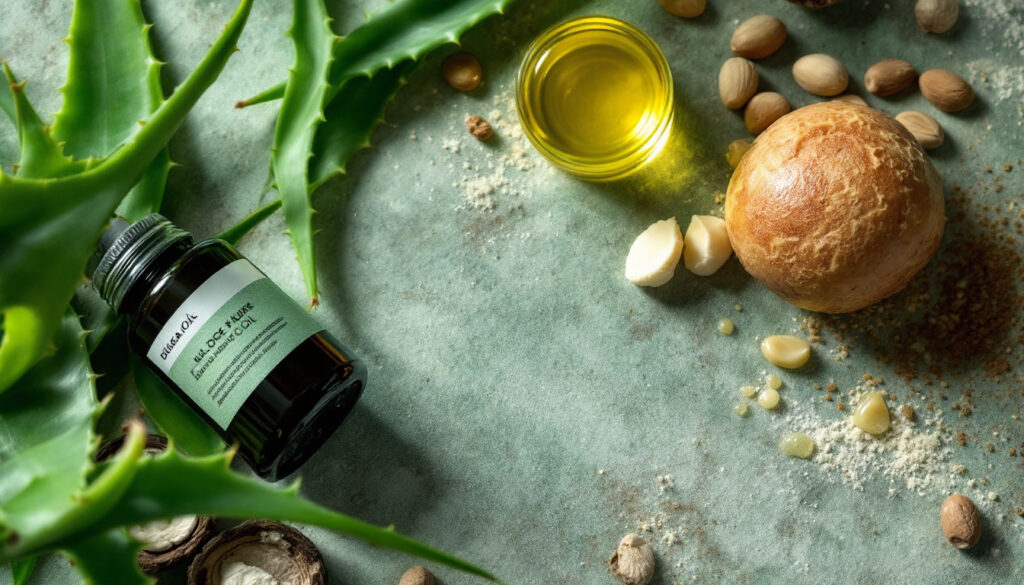Lately, there’s been a huge shift towards natural skincare, and honestly, it makes perfect sense. More and more people are becoming aware of what’s in their products and how those ingredients affect not just their skin, but also the environment. It’s about more than just looking good—it’s about feeling good in your skin, too.
I’ve personally noticed how much better my skin responds to organic skincare options. Fewer breakouts, less irritation, and this healthy, natural glow that’s hard to get with some of those heavy, synthetic formulas. It’s amazing how something as simple as switching to clean beauty products can make such a difference. Plus, there’s peace of mind knowing that what I’m using is free from harsh chemicals and, in many cases, cruelty-free.
One of the best things about going natural? It’s incredibly gentle. Natural ingredients like aloe, jojoba oil, or shea butter work with your skin, not against it. And the added bonus? Many of these products come from eco-friendly brands that prioritize sustainable packaging and ethical sourcing. So not only are you treating your skin well, but you’re also making choices that support the planet.
Understanding Natural Skincare
When we talk about natural skincare, we’re referring to products made with ingredients derived from nature—think plant extracts, essential oils, and minerals. These ingredients are often minimally processed to retain their natural benefits.

On the other hand, many conventional skincare products rely heavily on synthetic ingredients, which are created in labs and may include chemicals like parabens, sulfates, or artificial fragrances. The key difference is that natural ingredients are sourced directly from nature, while synthetic ones are man-made.
One important thing to remember is that just because something is labeled as natural doesn’t always mean it’s better for your skin or completely free of harmful ingredients. This is where learning to read labels becomes so important. If you’re serious about switching to natural skincare ingredients, take a closer look at the ingredient list.
Words like organic and clean beauty are great starting points, but they need to be backed up by solid certifications. For example, look for certifications like USDA Organic or COSMOS, which guarantee that the products are made with a high percentage of natural, sustainably sourced ingredients.
It’s also worth mentioning that even natural ingredients can sometimes cause irritation for sensitive skin types, so it’s all about finding what works best for your skin. The more you understand what’s inside your beauty products, the more empowered you are to make choices that support your health and well-being.
Ultimately, being mindful of the products you use not only benefits your skin but also supports a more sustainable approach to beauty. It’s all about balancing effective results with the peace of mind that you’re using organic beauty products that align with your values.
Benefits of Natural Skincare
The benefits of natural skincare are hard to ignore, especially once you realize how much more your skin can thrive without the burden of harsh chemicals. One of the main advantages of using products with natural, plant-based ingredients is that they tend to be much gentler on the skin.
Many conventional skincare products contain synthetic preservatives, dyes, or fragrances that can cause irritation, particularly for those with sensitive skin. In contrast, natural skincare products, which are free from these potentially harmful additives, significantly reduce the chances of breakouts, redness, or allergic reactions. It’s like giving your skin a break from the chemicals that weigh it down.
Another major plus is the long-term health of your skin. Because organic skincare products often include nourishing ingredients like vitamins, antioxidants, and essential fatty acids, they support the skin’s natural processes.
For example, ingredients like aloe vera, rosehip oil, and green tea extract are known for their anti-inflammatory and hydrating properties, promoting healthy skin renewal and improving texture over time. Over the years, I’ve seen how consistent use of these natural ingredients results in smoother, more resilient skin that doesn’t rely on heavy synthetic formulas to stay balanced.
There’s also a growing body of scientific research supporting the benefits of using organic skincare products. Studies have shown that certain plant-based ingredients like jojoba oil mimic the skin’s natural sebum, helping to regulate oil production without clogging pores.
Other studies highlight the powerful antioxidants in natural extracts, which help neutralize free radicals and slow the signs of aging. Essentially, natural skincare works with your skin’s biology, not against it.
Beyond the personal benefits, choosing natural products also has a positive impact on the environment. Many synthetic ingredients, especially those derived from petrochemicals, can harm ecosystems when they enter the water supply or soil.
Natural skincare products, particularly those labeled as clean beauty, are often produced by companies with strong ethical standards—prioritizing eco-friendly packaging, cruelty-free testing, and sustainable sourcing of ingredients. This means that by switching to natural products, you’re not only doing something good for your skin, but you’re also reducing your overall environmental footprint.
In short, the shift to natural skincare is about more than just a trend. It’s about choosing products that offer real, long-term benefits for your skin and for the planet. Your skin deserves ingredients that are as pure as possible, and with the right choices, you can see the difference both on the surface and in the long run.
Assessing Your Current Routine
Assessing your current skincare routine is the first step toward making more conscious choices for your skin and overall well-being. It’s easy to fall into a habit of using the same products for years without giving much thought to what’s actually inside them. But taking a closer look at those ingredient lists can reveal a lot about what your skin is absorbing daily.

When evaluating your products, start by identifying natural skincare ingredients to avoid. Some ingredients, even though they might be common, can actually do more harm than good. For instance, parabens are widely used as preservatives but have been linked to potential hormone disruption.
Sulfates, often found in cleansers and shampoos, can strip your skin of natural oils, leading to dryness and irritation. Phthalates are another red flag—they’re used to make products more pliable but are known for their potential to interfere with the endocrine system. These are the kinds of synthetic ingredients that don’t belong in a clean beauty routine.
One way to approach this is to become a label reader. The shorter the ingredient list, the better. Look for terms you recognize, like aloe, chamomile, or essential oils, rather than chemicals you can’t pronounce. If you see too many artificial fragrances or colorants, it’s a good sign that the product might not be the best fit for your skin.
Another tip is to familiarize yourself with certifications like USDA Organic or ECOCERT, which can help ensure that a product meets strict guidelines for using clean, natural ingredients. These labels make it easier to navigate the overwhelming amount of information out there.
Making small swaps—like choosing a sulfate-free cleanser or a paraben-free moisturizer—can make a big difference in how your skin feels and looks. By phasing out harmful ingredients, you’re giving your skin the best chance to glow naturally.
Creating Your Natural Skincare Routine
Creating a natural skincare routine doesn’t have to be overwhelming, and the best part is that it can be tailored to your unique skin type—whether it’s oily, dry, sensitive, or a combination.
The key is choosing products with nourishing, plant-based ingredients that work in harmony with your skin’s natural processes. Here’s a step-by-step guide to get you started, along with some product recommendations based on your skin type.
1. Cleansing: The First Essential Step
For all skin types, a gentle cleanser is a must. Cleansing removes dirt, oil, and impurities without stripping your skin’s natural moisture. If you have oily skin, opt for a gel-based cleanser with ingredients like tea tree oil or witch hazel, which help control excess sebum.
One of the best natural skincare routines for oily skin would include a cleanser like Trilogy Balancing Gel Cleanser, which uses plant-based ingredients to deep clean without being harsh.
For dry or sensitive skin, you’ll want something hydrating and soothing. Look for cleansers that contain aloe vera, chamomile, or oat extract. These ingredients cleanse while calming irritation. Try Pai Camellia & Rose Gentle Hydrating Cleanser if your skin needs extra TLC.
2. Toning: Restoring Balance
Toners help balance your skin’s pH after cleansing, prepping it for the next steps. For oily skin, choose a toner that helps minimize pores and controls oil production without drying out your skin. Thayers Alcohol-Free Witch Hazel Toner is a great option for its balancing properties and soothing ingredients like rose water.
Dry and sensitive skin types should look for toners that hydrate and calm, rather than astringent formulas. Try Herbivore Botanicals Rose Hibiscus Hydrating Mist, which adds moisture and soothes sensitive skin with natural ingredients.
3. Moisturizing: Locking In Hydration
Moisturizing is essential for every skin type, but the type of moisturizer you choose will vary. Oily skin still needs hydration, so look for a lightweight, oil-free moisturizer that won’t clog your pores. Dr. Hauschka’s Melissa Day Cream is a great option, as it provides moisture without adding excess oil, while its lemon balm content helps balance sebum production.
For dry skin, reach for a richer, creamier product that deeply hydrates. Ingredients like shea butter, jojoba oil, and hyaluronic acid are your best friends. Weleda Skin Food is a top recommendation—it’s packed with nourishing oils that help lock in moisture for a lasting glow.
Sensitive skin types should prioritize simple, fragrance-free formulas with soothing ingredients like calendula or chamomile. Avène’s Skin Recovery Cream is a fantastic choice from one of the best natural skincare brands for sensitive skin, offering a gentle, non-irritating option for daily hydration.
4. Exfoliating: Keep It Gentle
Exfoliation is important for removing dead skin cells and promoting cell turnover, but natural exfoliants are the way to go to avoid irritating the skin. Oily skin types can benefit from a gentle physical exfoliant made with natural grains or enzymes. Acure Brightening Facial Scrub uses walnut shell powder and sea kelp to provide a refreshing, non-abrasive exfoliation.
Dry or sensitive skin should opt for a mild, enzyme-based exfoliator or something with very fine particles to avoid aggravating the skin. Juice Beauty’s Green Apple Peel Sensitive is a gentle option that helps to brighten and resurface the skin without causing irritation.
5. Treatments and Serums: Addressing Specific Concerns
Serums are where you can target specific skin concerns like fine lines, hyperpigmentation, or acne. For oily skin, a serum with niacinamide or salicylic acid can help manage breakouts and control excess oil. Try The Ordinary Niacinamide 10% + Zinc 1%, which is a cult favorite for balancing oil production and calming blemishes.
Dry skin types should look for serums with hyaluronic acid or squalane to boost hydration. Biossance’s Squalane + Vitamin C Rose Oil is a luxurious serum that helps plump the skin and provides lasting moisture.
For sensitive skin, stick with serums containing calming, anti-inflammatory ingredients. Pai’s Rosehip Bioregenerate Oil is a top choice for its ability to repair and soothe the skin without causing irritation.
6. Sun Protection: Non-Negotiable
The final step in your routine, no matter your skin type, should always be sun protection. Look for a mineral-based sunscreen that uses zinc oxide or titanium dioxide, which are natural physical blockers that won’t irritate the skin. For oily skin, try Juice Beauty’s Oil-Free SPF 30 Moisturizer, which offers sun protection without adding shine.
Sensitive or dry skin can benefit from Badger’s SPF 30 Clear Zinc Sunscreen, which is gentle, moisturizing, and free of synthetic fragrances or preservatives.
Transitioning Gradually
Transitioning to a natural skincare routine is a process that should be done thoughtfully and gradually. It might be tempting to toss out all your products and replace them overnight, but switching too quickly can actually overwhelm your skin and wallet. The key to success is patience and a step-by-step approach that allows your skin to adjust to the new ingredients while giving you time to find the right products.
1. Start With the Essentials
If you’re wondering how to create a natural skincare routine without feeling overwhelmed, the best place to begin is by focusing on key products. Instead of trying to swap out everything at once, start with the basics: your cleanser, moisturizer, and sunscreen. These are the cornerstones of any routine, and replacing them with clean, natural alternatives can make a big difference in the overall health of your skin.
For example, switch to a gentle, sulfate-free cleanser like Burt’s Bees Sensitive Facial Cleanser if you’re currently using something harsh or drying. Next, opt for a lightweight, plant-based moisturizer and a mineral-based sunscreen to keep your skin protected while nourishing it with natural ingredients. This initial swap will help set a foundation for healthier skin without overwhelming it with too many changes at once.
2. Replace Products as They Run Out
A great strategy for making a smooth transition is to replace products as you use them up. This gradual method prevents waste and allows you to invest in high-quality natural skincare products one at a time. For example, if you’ve just finished your current toner, look for a natural alternative like Heritage Store Rosewater & Glycerin, which balances and hydrates with minimal ingredients. Doing this for each product ensures that you’re consistently upgrading your routine without unnecessary waste or cost.
3. Introduce One New Product at a Time
It’s important to introduce new products slowly to see how your skin reacts. Skin can sometimes go through an adjustment period, especially if you’ve been using synthetic or harsh ingredients for a long time. Try adding one new natural product to your routine every couple of weeks to avoid overwhelming your skin. This also gives you a chance to see if any specific product causes irritation or breakouts, allowing you to troubleshoot before moving on to the next swap.
4. Focus on Targeted Treatments Last
Once you’ve successfully transitioned your basics—cleanser, moisturizer, and sunscreen—then you can focus on targeted treatments like serums, exfoliants, or masks. These products are often more concentrated and should be chosen based on your specific skin concerns.
For example, if you’re dealing with dullness or acne, you could introduce a serum with vitamin C or niacinamide, like Mad Hippie Vitamin C Serum, known for its brightening and antioxidant properties.
After establishing your routine, explore our comprehensive guide on Natural Skincare for Sensitive Skin for specialized tips.
DIY Natural Skincare
One of the great things about DIY natural skincare is that you can create effective, personalized treatments with ingredients you probably already have at home. From face masks to scrubs, making your own skincare products allows you to control exactly what goes on your skin, avoiding harsh chemicals and synthetic additives.
Plus, it’s often more affordable and eco-friendly. However, it’s important to approach DIY with a bit of caution to ensure that your homemade products are both safe and effective.
1. DIY Face Masks
Face masks are a great place to start with DIY skincare. A simple hydrating mask can be made with just two ingredients: honey and yogurt. Honey is a natural humectant, which means it draws moisture into the skin, while yogurt contains lactic acid, a gentle exfoliant that helps brighten and soften skin. Mix equal parts of each and apply for 10-15 minutes to give your skin a nourishing boost.
For those dealing with acne, a mask using ingredients like turmeric and honey can work wonders. Turmeric has anti-inflammatory properties, which can help reduce redness and swelling, while honey’s antibacterial qualities make it great for acne-prone skin. Just mix one teaspoon of turmeric with one tablespoon of honey and leave it on for 10 minutes before rinsing.
2. DIY Scrubs
Exfoliation is key to smooth, glowing skin, and you can easily make a natural scrub at home. One of the easiest DIY scrubs combines sugar and coconut oil. The sugar acts as a gentle physical exfoliant, while the coconut oil deeply hydrates. Mix two parts sugar with one part coconut oil, and you have a nourishing scrub that’s perfect for sloughing off dead skin cells.
If you’re looking for something a bit stronger, especially for oily or acne-prone skin, try a scrub using oatmeal and baking soda. Oatmeal soothes the skin, while baking soda provides gentle exfoliation. Just be sure to use this scrub no more than once or twice a week to avoid over-exfoliation.
3. Effectiveness and Safety
While DIY natural skincare products for acne and other needs can be effective, it’s essential to be mindful of ingredient safety. Not all natural ingredients are suitable for everyone.
For example, lemon juice is often recommended in DIY recipes, but it can actually be too acidic for the skin and cause irritation, especially when exposed to sunlight. Similarly, baking soda is great in small amounts, but using it too often can disrupt your skin’s pH balance, leading to dryness or sensitivity.
When making your own products, always do a patch test first to ensure your skin doesn’t react negatively. And remember, even though natural ingredients can be powerful, they don’t always have the same preservative qualities as store-bought products, so make only small batches and use them within a short period to avoid bacterial growth.
Tips for Beginners
If you’re just starting out with natural skincare, welcome to a cleaner, more mindful approach to caring for your skin! Making the switch can feel exciting, but it’s important to ease into it with some practical steps. Here are a few natural skincare tips for beginners to help you get started on the right foot.
1. Patch-Test Everything
Before diving into a full skincare routine, always patch-test any new product—whether it’s store-bought or DIY. To do this, apply a small amount of the product to an area like the inside of your wrist or behind your ear.
Leave it on for 24-48 hours to see if any redness, itching, or irritation occurs. This helps you avoid potential allergic reactions or sensitivities before using a product on your face.
2. Start Simple and Gradually Add New Products
When transitioning to natural skincare, less is more, especially in the beginning. Start with the basics—a gentle cleanser, moisturizer, and sunscreen. You can always add in serums, masks, or exfoliators once your skin has adjusted. It’s all about giving your skin time to respond positively to the new ingredients.
3. Expect a Transition Period
During the first few weeks of switching to a natural skincare routine, you might notice some changes in your skin—both good and bad. Some people experience minor breakouts or increased oiliness as their skin detoxifies from synthetic products. This is normal, and it usually clears up within a few weeks. Stick with it, and your skin will gradually adapt to the new, gentler ingredients.
4. Be Consistent
Consistency is key in any skincare routine, but it’s especially important with natural products. Results may take longer to show compared to synthetic treatments, but with patience, you’ll likely notice healthier, more balanced skin over time.
Conclusion
Embracing a natural skincare routine is more than just a trend—it’s a thoughtful way to take care of your skin while making informed, sustainable choices. By choosing products with clean, plant-based ingredients, you’re giving your skin the nourishment it needs without the harsh chemicals that can lead to irritation or long-term damage.
The benefits of natural skincare include gentler formulations, fewer breakouts, and healthier, glowing skin over time. Plus, many organic beauty products are created by brands that prioritize eco-friendly practices, which means you’re making a positive impact on the environment, too.
Transitioning to a natural routine doesn’t have to happen overnight. Start small by replacing key products like cleansers or moisturizers, and always patch-test new items to ensure they work for your skin. DIY options can also be a fun and effective way to customize your routine, but remember to use safe ingredients and always test for allergies or sensitivities.
Ultimately, the journey to healthier skin starts with understanding what goes into your products. By being mindful of the ingredients and making choices that align with your skin’s needs and your values, you’re investing in long-term skin health that feels as good as it looks.
FAQ: Natural Skincare Essentials
Whether you’re new to natural skincare or looking to deepen your knowledge, it’s important to have clear, reliable answers to common questions. Below, we’ve addressed frequently asked questions to help guide you through the world of natural skincare, from product recommendations to creating effective routines. Let’s dive in!
What are the best natural skincare brands?
Some highly regarded natural skincare brands include Pai Skincare, Herbivore Botanicals, Weleda, Juice Beauty, and Tata Harper. These brands focus on clean, organic ingredients and ethical sourcing while delivering effective results for different skin types.
How do I create an effective natural skincare routine?
Start with the basics: a gentle cleanser, moisturizer, and sunscreen. Gradually introduce products like toners and serums that target specific concerns (e.g., acne, dryness). Focus on high-quality, natural ingredients tailored to your skin type, and build consistency for long-term results.
What ingredients should I avoid in natural skincare products?
Avoid ingredients like parabens, sulfates, synthetic fragrances, and phthalates. Even in natural products, these can irritate the skin or cause harm with long-term use. Always check the labels for truly clean and safe formulations.
Can natural skincare help with acne?
Yes! Many natural ingredients are effective against acne, such as tea tree oil, witch hazel, and aloe vera. These ingredients can reduce inflammation, fight bacteria, and control oil production without stripping your skin or causing irritation.
What are the benefits of using organic skincare products?
Organic beauty products are free from harmful chemicals, pesticides, and synthetic additives. They’re gentler on the skin, reduce the risk of irritation, and often contain more nourishing ingredients like antioxidants and vitamins that promote healthier, glowing skin.
Are DIY natural skincare products safe to use?
DIY skincare can be safe if you use the right ingredients and formulations. Stick to gentle, nourishing ingredients like honey, oats, or yogurt, and avoid overly harsh items like lemon juice or undiluted essential oils. Always patch-test first to avoid irritation.
How often should I update my natural skincare routine?
Update your skincare routine as your skin’s needs change, typically with the seasons. You might need a richer moisturizer in winter or lighter products in summer. It’s also a good idea to reassess your routine every 6-12 months to ensure it’s still effective.
What natural skincare products are best for sensitive skin?
For sensitive skin, look for products with soothing ingredients like chamomile, aloe vera, and calendula. Brands like Pai Skincare and Avène offer gentle, fragrance-free formulas that hydrate and calm irritated skin without causing reactions.
How can I start a natural skincare regimen on a budget?
Start small by focusing on essential products like cleanser and moisturizer. Look for affordable yet high-quality brands like Burt’s Bees or The Ordinary. You can also incorporate DIY treatments, using ingredients like oats or coconut oil, which are both effective and inexpensive.
What are the top natural skincare tips for beginners?
Patch-test new products to avoid reactions.
Start with a simple routine (cleanser, moisturizer, sunscreen).
Gradually introduce new products and be patient with results.
Stay consistent and avoid switching products too frequently.
Read labels carefully to ensure products are truly natural.








